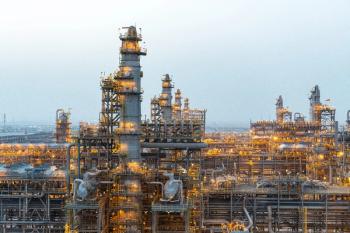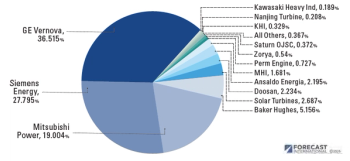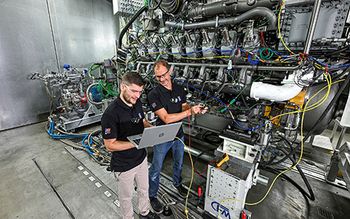
How realistic are combined cycle efficiency targets?
Below are excerpts from the paper, “Etude on Gas Turbine Combined Cycle Power Plant – Next 20 Years” presented by S Can Gülen,
Bechtel
Corporation, at the ASME Turbo Expo 2015.
GTCC efficiency evolution over the last three decades does not display any discernible technology breakthroughs. What is in store for the GTCC technology in the near- to mid-term, i.e., next 15 to 20 years? The metric that will be used is the net GTCC efficiency at ISO base load. 63% net GTCC efficiency seems to be the upper limit, which requires 43% and 76% in topping and bottoming cycle (net exergetic) efficiencies, respectively. To reach 65%, one needs 45% Brayton cycle efficiency and 78% net bottoming cycle exergetic efficiency (with 700 C GT exhaust temperature).
How plausible are these values? An ideal, uncooled GT with zero losses and 100% component efficiencies represents the theoretical entitlement (in essence, a Carnot cycle). It can be shown that for a given cycle maximum temperature (i.e., TIT for a gas turbine) there is an optimal cycle PR for either maximum cycle efficiency (which impacts operating costs) or maximum cycle specific work (which impacts the capital investment, i.e., the “first cost”). It can also be shown that for the maximum GTCC efficiency, the optimal GT cycle PR is very close to the value for maximum GT specific work. This theoretical conclusion is confirmed by the design parameters of actual production machines.
Actual state-of-the-art GT efficiencies in a TIT range of 1,300-1,700 C covering E through J class machines fall on a line, which is in very good agreement with the ideal efficiency multiplied by a factor of 0.75 (the Carnot factor). Interestingly, this factor is in good agreement with the Rankine (steam) bottoming cycle exergetic efficiency. Noting that the GT fuel energy input is roughly equal to the fuel exergy, the conclusion is that today’s state-of-the-art in GTCC technology is capable of achieving about three quarters of the theoretically possible maximum thermal efficiency (100% is unattainable – it would require a Carnot cycle).
Transferring new technology (mainly HGP materials, coatings, cooling flow reduction and higher component efficiencies) from the latest G/H/J classes, old F class machines (1,400 C TIT – maybe somewhat higher) can attain efficiencies with a Carnot factor of 0.80. Another way to achieve that level is via cycle modification, e.g., reheat or sequential combustion. Modern compressor and turbine efficiencies (90+% ~90%, respectively) are so high that little room is left for significant improvement. It is safe to assume that, without significant reduction in HGP cooling flows, Carnot factors above 0.80 are extremely unlikely.
The highest envisioned TIT (as of today) is 1,700 C (~3,100 F). This is at or beyond the upper limit of advanced Dry-Low-NOx (DLN) combustion technologies (with axial fuel staging), where NOx production increases exponentially. In fact, the OEM pursuing the 1,700 C TIT “super J” class GT had to consider exhaust gas recirculation (EGR) for NOx control, adding significant cost and complexity to the design.
CLSC: Closed-Loop Steam Cooling, R/C: Reheat or Sequential Combustion. BC: Bottoming Cycle
Table summarizes the predictions for the next two decades of natural gas fired gas turbine combined (integrated?) cycle performance. The performances should be interpreted as commercially acceptable and field-proven values satisfying RAM and durability requirements per established SOA.
The “likelihood grades” in the table (they are subjective qualifiers based on the author’s experience fortified by the data and first principles outlined in the current paper) should be interpreted with that caveat in mind.
On the other hand, under the light of recent developments (e.g., increasing penetration of renewable technologies such as wind and solar into the generation portfolio) equipment design features such as fast start, steep load ramps, relative insensitivity of efficiency to lower loads and high ambient temperatures, compliance with emissions regulations over a wide operating envelope are as important (if not more so) than a single-point efficiency. Thus, a better metric to focus on is a mean-effective efficiency over a well-defined range of duty cycle, which incorporates all the aforementioned features in a rational manner. Calculations show that such an average number is several percentage points lower than the ISO base load efficiency.
Coda
In 1941, a committee of experts, including such luminaries as von Karman and Millikan, opined that “the gas turbine could hardly be considered a feasible application to airplanes” (see page 24 of Wilson & Korakianitis). A mere three years later, German aces in Galland’s “squadron of experts” JV-44 were plying European skies in Jumo-004 powered Me-262. Expert opinions such as those asserted herein are prone to embarrassing rebuttal by actual developments – sometimes within a very short time span.
While the author cannot claim immunity to the same fate, in all fairness, it should be pointed out that such a fate almost always befalls opinions proclaimed on revolutionary technology changes that can be classified as “zero to one”. The technology examined herein is an extremely mature one with limited room left only for evolutionary improvement as dictated by fundamental laws of nature.
Presently unknown “quantum jumps” in technology or hybrids with other technologies are outside the scope of the current work. Whether they have any chance of turning into real products in the next two decades is subject to speculation.
Newsletter
Power your knowledge with the latest in turbine technology, engineering advances, and energy solutions—subscribe to Turbomachinery International today.





